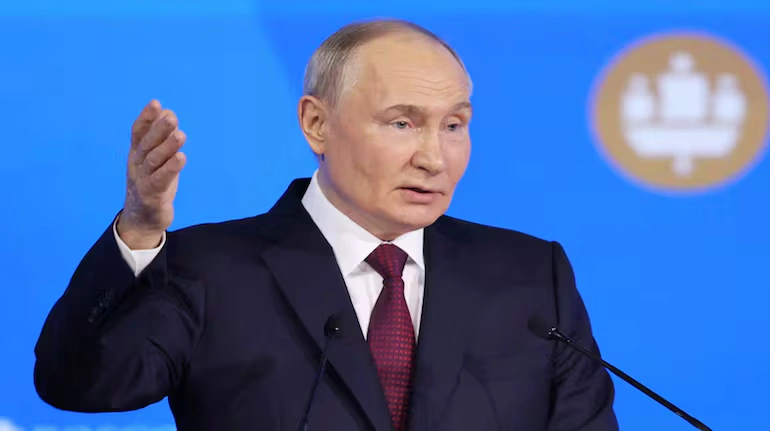Russia Proposes Three-Day Ceasefire in Ukraine from May 8–10: Kremlin Warns of Retaliation if Provoked
In a major step amid the current war in Ukraine, Russia once again reaffirmed its intention to conduct a total temporary ceasefire between May 8 and May 10, overlapping with its Victory Day celebrations annually. The Kremlin demands that its troops respect President Vladimir Putin’s order for a 72-hour ceasefire but clarified that Russia will retaliate aggressively if Ukrainian forces initiate attacks over this period. The statement is a new added complexity to an already explosive dynamic, as the President of Ukraine, Volodymyr Zelenskyy, indicates opposition to such a temporary cessation of combat.

Kremlin’s Announcement: A Ceasefire with Conditions
Tuesday saw Kremlin spokesman Dmitry Peskov verifying that Russia will go ahead with the scheduled ceasefire, initially announced by President Putin on April 28. It is to go into effect May 8, and then will run through both May 9 and May 10. In Russia, all of these days are highly symbolic, particularly May 9 as it is the day of the Soviet Union victory over Nazi Germany in World War II, a holiday known as Victory Day.
The Kremlin made it clear, however, that although Russian forces will refrain from firing, they have the right to return fire against any aggression. “If Ukrainian forces carry out strikes or provocations during the period of ceasefire, our military will react firmly,” Peskov warned. The remark highlights the tentative nature of the ceasefire, casting it more as a goodwill gesture than a negotiated peace.
Victory Day: A Political and Symbolic Context
Victory Day is of great cultural and political importance in Russia. The May 9 holiday is not just a national holiday commemorating the Soviet Union’s victory over fascism but also a pillar of contemporary Russian identity and patriotism. President Putin frequently uses the holiday to mobilize domestic support and reaffirm Russia’s place in the world.
This year’s festivities have greater significance. Russia is celebrating the 80th anniversary of the victory in World War II, and a big military parade will be held in Moscow’s Red Square. VIP guests, such as Chinese President Xi Jinping, are invited, adding to the international optics of unity and power that the Kremlin desires to portray.
Ukraine’s Response: Demands for a Meaningful Ceasefire
Ukrainian President Volodymyr Zelenskyy has so far remained unconvinced by the ceasefire move from Moscow. Though Kyiv hasn’t outright rejected the proposal, Zelenskyy has indicated that Ukraine is not looking for symbolic or fleeting pauses.
Speaking in a recent speech, Zelenskyy said he would only entertain a ceasefire of “at least 30 days,” stressing the importance of serious and sustainable de-escalation and not what he views as short-term PR stunts by Russia.
“Such a peace, there can’t be in mere three days,” Zelenskyy had stated. “If we’re going to make a ceasefire now, it would have to be with the expectation of making the way for some real negotiations and a long-lasting solution.”
That view is supported by military observers who caution short ceasefires have been used as a tactical opportunity to regroup and reequip instead of for actually working for peace.
The Military Situation on the Ground
Through early May, there is ongoing fighting in a number of key areas of eastern and southern Ukraine. Russian military forces have kept pressure in and around Donetsk and Kharkiv, and Ukrainian forces are making counterattacks to take back lost ground. Civilian deaths keep accumulating and have reached catastrophic proportions in some regions.
Experts indicate that it will be hard to impose a three-day ceasefire without firm agreements on monitoring or enforcement. In the absence of mutual trust or international observers on the ground, there is a strong likelihood of violations by either party, which may revive hostilities even more intensely.
Diplomatic Reactions and Global Implications
The global community has reacted cautiously to Russia’s offer of a ceasefire. Some have embraced the suggestion in principle, especially as a humanitarian gesture to provide aid or evacuate civilians. Others are wary, suspicious of the Kremlin’s motives and whether such a brief halt in fighting would work.
The United Nations and European Union alike have both reinforced demands for a more durable ceasefire supported by an architecture for talks. Nevertheless, persistent distrust as well as an absence of communications between Moscow and Kyiv still pose considerable stumbling blocks.
Western powers, particularly the United States and the United Kingdom, have underlined that any ceasefire should not be utilized by Russia to regroup forces or stall Ukraine’s gains. Transparency and verifiable assurances are what NATO officials have demanded if there is to be any break in fighting.
The Stakes for Both Leaders
For Vladimir Putin, the ceasefire is an opportunity of strategy to realign global perception. While all eyes are upon Moscow on Victory Day, Putin would like to present himself as a peacemaker without trading away Russia’s military bargaining chip.
For Volodymyr Zelenskyy, to accept a ceasefire without commitment would be dangerous from both the political and the military point of view. By doing so, he may hurt his domestic stature and also dash the morale of Ukrainian soldiers concerned about Russian ulterior motives.
Both leaders are playing to their constituency — Putin to the home front and international friends such as China, and Zelenskyy to a war-fatigued country that insists on accountability and concrete change.
Ceasefire or Strategic Pause?
The proposed May 8–10 ceasefire in Ukraine is being closely monitored by governments, diplomats, and military analysts across the globe. While the move can be seen as a gesture of a temporary cessation of hostilities, its success would rely on intentions and conduct of both sides during the break.
Russia insists it will honour the ceasefire but warns it will retaliate if attacked. Ukraine, on its part, demands a meaningful, not so temporary end to the war, declining to accept symbolic moves without substance.
In the end, this truce will not perhaps produce peace, but it may give a peep into deeper diplomatic trenches still to come. Whether it contributes to a true breakthrough or develops as yet another footnote in one of history’s greatest wars lost by opportunities for peace, is still to come.
Click here to subscribe to our newsletters and get the latest updates directly to your inbox.

